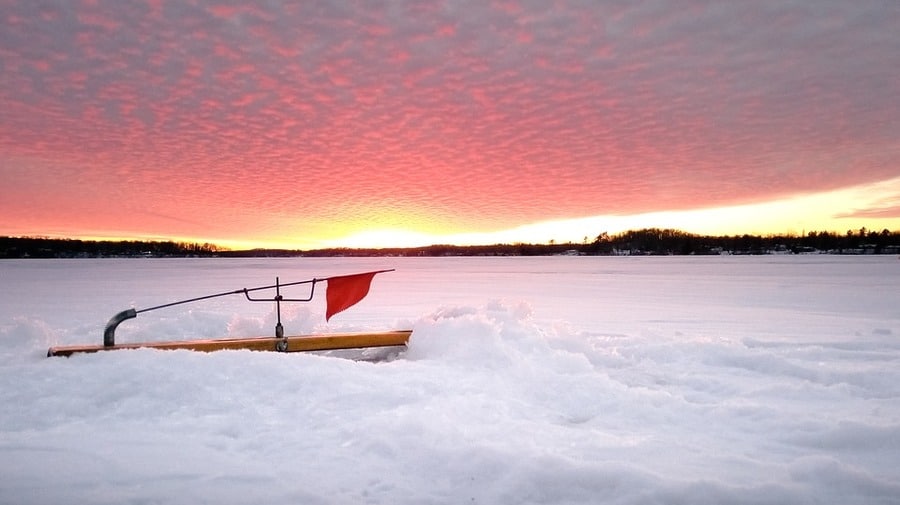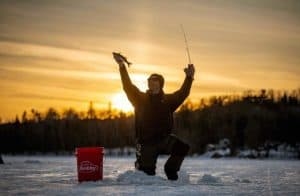Ice Fishing for Bluegills at Night: Can You Catch Them?

Leave a comment after this article and let’s talk more about fishing. I’d love to read your feedback.
Bluegill can be one of the most commonly caught fish for ice fishermen and are prized because of their delicate white flesh. Bluegill will bite all day long but a lot of ice fishermen have trouble catching them at night. The truth is night fishing for cold-water bluegills can be tough but it can also be awesome if you do it right.
Do bluegill bite at night during the winter for ice fishermen? Bluegill typically are caught by ice fishermen during the day in larger numbers but night fishing can be very rewarding. You will need to increase the size of your bait and jig it a little slower, but you can catch a lot of large bluegills after the sun goes down.
Check out this helpful guide on the best water temperatures for bluegill fishing.
Where to Locate Night Bluegill
During the winter, bluegill will oftentimes associate with deeper holes adjacent to shallow weedy bays or beds. The deeper water will typically be a bit warmer than shallower water and thus attract more food for bluegill.
Look for holes deeper than the average relative water depth around it. If you are fishing over a bay that is about 6 feet deep and you find a deep hole that is 20 feet deep, bluegill and other gamefish will congregate in these areas.
At night, these can be awesome locations to catch your bag limit of bluegills, crappie, and even walleyes. Just be prepared to hole-hop if the bites slow down or the fishing turns off. Another great location for nighttime bluegills is in and around deep weed edges and near any sunken timber in water greater than 10-feet deep.
Click here for a complete breakdown of bluegill fishing at night. You may also be interested in an article we wrote on how weather factors impact bluegill fishing.
Best Time to Catch Winter Bluegill
During the winter, the best time of day to catch bluegill is mid-to-late afternoon from my own experience. These always seem to be the optimum fishing windows when bluegills are hungry and willing to bite.
If you know a snowstorm is about to dump, fishing right before the event can also catch you awesome fish. But don’t neglect the night bite. When ice fishing, you can experience incredible fishing by fishing at night in the proper locations.
If you have an LED glow light under your hole, you can draw in bluegill and other gamefish by the dozens all night long.
Fishing with a glow light can turn a good bite into a consistently awesome one for hours and hours. To learn when the best times of day are to catch more and bigger bluegills in every season, check out this article I wrote.
Best Baits for Night Bluegill Ice Fishing
The best baits to catch bluegill on while ice fishing are small minnows, mealworms, waxworms, or small jigheads. You want a small profile bait you can jig in front of schooling bluegills to entice them to bite.
The same holds true for fishing them at night but I recommend upsizing your bait some. Go with a slightly larger jighead or adding two waxworms to the hook instead of just one. Give the panfish something to lock onto in the dark.
The fish will have a harder time locating your bait at night so going a little larger will only help them out. Selecting a very lively fathead minnow can be great too. The lively minnow will struggle and swim aggressively.
This vibration will alert panfish and send bluegills into a frenzy to locate the struggling baitfish before other fish do.
They will be able to locate your bait in the darkness by following its vibration. You can also jig your baits a little slower or a little faster than normal to experiment. Find out what the bluegills are keying into.
How to Catch Bluegill at Night
Jigging
Jigging is the most effective but hands-on (literally) method for ice fishing for bluegills. Bluegill eat tiny baits in the winter and when that water is cold and all movements are slow, a wiggling and vibrant jig being worked will draw in panfish.
While jigging is a great way to catch panfish during the day, jigging at night can be a great way to load the frying pan. I would recommend upsizing your baits for nighttime jigging though.
The darkness makes it very hard for bluegill to locate food. Tie on a slightly bigger jig, a larger minnow, or add two waxworms to the hook instead of one.
You can also add a touch of glow to your presentation. I like using green glow-in-the-dark jigheads to give fish something to zero in on at night.
Deadsticking

Deadsticking is essentially live bait “drift” fishing through the ice. The best bait you can use is lively minnows or small golden shiners because these baits will swim around and be able to draw in gamefish in the dark.
Mealworms, waxworms, and even nightcrawlers can be good deadsticking baits as well for bluegill. I have even caught catfish and bluegill using sweet corn kernels while deadsticking.
One thing I recommend doing is deadsticking one hole while you jig another. This will allow you to fish two holes using two different techniques at once. Having two baits in the water close to each will help draw in waves of bluegill in the darkness.
Tip-Ups
Tip-ups are my go-to ice fishing technique. I love using tip-ups for pickerel, pike, and catfish but they can be used for bluegill. You must downsize the baits tremendously to target panfish on the tip-up.
Try fishing with a small fathead minnow, a small shiner, or a mealworm. One thing I recommend doing is using a 2-foot leader of 2 or 4-pound test fluorocarbon. Fluorocarbon naturally sinks and is extremely hard for fish to see.
I also recommend using a single split shot to keep your bait suspended down deep and a glow light or bell to place on your tip-up flag. You don’t want a bluegill biting your line in the dark and you not being able to see the flag go up.
Invest in a Good Ice Flasher
An ice flasher is a must-have for a lot of ice fishermen. It can show you the presence of fish and show when a fish is interested in your bait or not.
There are a ton of great ice flashers on the market worth using but I actually recommend going with a castable fish finder instead.
The Deeper Pro + castable fish finder (link to Amazon) has a good ice flasher mode for ice fishing that is comparable to many ice flashers on the market. Why I recommend this product over a standard ice flasher is the ice flasher is good only for ice fishing.
You can use the Deeper Pro + to fish through the ice or to locate fish while bank fishing, boat fishing, or dock fishing. It is simply a much more versatile product you can use all year long vice only in winter.
What About Fishing Lights?
Invest in a set of LED fishing glow lights. These things will catch you fish. It sounds gimmicky but they will draw in fish for hours and keep a hole viable potentially all night long. These LED lights can be dropped beneath a nearby ice hole and really illuminate the entire area with a soft green light.
Plankton and microorganisms will be drawn in first, followed by hungry baitfish. Curious crappie, bluegill, and perch will follow and also start snacking on baitfish. Don’t expect immediate results.
It can take more than an hour for the whole process to start delivering larger fish. But just know that even though small fish will show up first, the quality and quantity of fish will improve the longer you wait.
Instead of having to hole-hop, you can literally position over a pretty good section of weedline and wave after wave of bluegill will be drawn in every hour you are out there. There are many great LED fishing lights out there, but I think these LED fishing lights are one of the best ones and are priced very affordably at Amazon.
Tips for Getting Bluegill to Bite at Night Ice Fishing
1. Prepare to Hole-Hop
Anytime you are ice fishing for panfish, you need to be prepared to bounce from hole-to-hole chasing the bite. Bluegill roam in small pockets across the lake.
Once you catch all the fish in one pocket, you need to go find another pocket. This is especially true at night as bluegill are very unwilling to swim after dark. You need to go to them. Now if you are LED glow lights, the fish will come to you.
2. Set-Up Before Sunset
It is smart behavior to set up your gear, get on the lake, and drill some holes before the sun sets. You will have a better grasp of your location on the lake and you won’t be fumbling with gear after dark.
3. 1st & Late 2 Hours of Darkness
Bluegill will be the most active feeding the first 2 hours of darkness and the last 2 hours of darkness. You can catch fish in the dead of night but you won’t catch nearly as much.
4. Invest in a Good Noodle Rod
I prefer using a good noodle ice fishing rod when targeting panfish at night. They are more sensitive and you can visually see bites on the flexible rod-tip.
